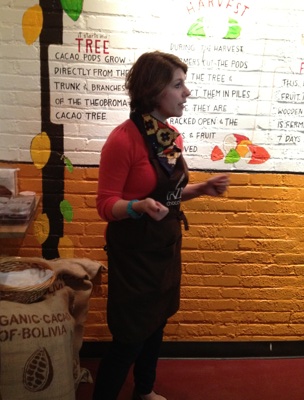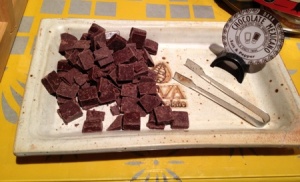DIY Recap: How to Make Chocolate with Taza
by Marshall Bright, CGNE youth member

When I was a kid, my favorite part of Mr. Rogers were the segments when we got to visit a factory and see how things were made, so when I heard about the opportunity to go to a DIY event where we got to visit a real-live chocolate factory, I knew I had to go.
Touring the Taza Chocolate factory was a dream come true for both the Mr. Roger’s fan and food nerd in me. Located in Somerville, MA, Taza offers daily tours led by their super-knowledgeable guides. Taza makes Mexican-style organic, fair-trade chocolate, which is a far cry from the milky, super-sweet stuff sold at grocery store counters.
We began the tour learning about what chocolate beans get up to before arriving in Somerville. Our guide explained how the cacao beans are harvested, and how Taza works directly with farmers to get the best quality beans possible in their chocolate. We also learned what makes Mexican-style chocolate so different from what Americans typically eat. Mexican chocolate is stone-ground and typically sold in rounds. No milk is ever added, instead, just coarsely-ground cane sugar. With much more of a crunch and complexity than many European-style chocolates, Mexican-style chocolate is most often used in Latin America to melt into drinks much more comparable to coffee than hot chocolate.
 Next we got to see where the beans are roasted. Roasting brings out a lot of the nuttiness in chocolate, and is a vital part of the process. This was also the step in the tour where we got to don our super-stylish hair nets. In the roasting room we got to try chocolate nibs, which is the shelled and roasted product halfway between cocoa beans and chocolate. Biting into it was a lot like sneaking a bite of the baker’s chocolate your mom had in the pantry when you were a kid. I knew no sugar was added, yet I was still taken aback by how bitter it tasted. We were then handed chocolate-covered nibs–much better.
Next we got to see where the beans are roasted. Roasting brings out a lot of the nuttiness in chocolate, and is a vital part of the process. This was also the step in the tour where we got to don our super-stylish hair nets. In the roasting room we got to try chocolate nibs, which is the shelled and roasted product halfway between cocoa beans and chocolate. Biting into it was a lot like sneaking a bite of the baker’s chocolate your mom had in the pantry when you were a kid. I knew no sugar was added, yet I was still taken aback by how bitter it tasted. We were then handed chocolate-covered nibs–much better.
Next, we got to see where the chocolate is wrapped and packaged. One thing that makes Taza unique is that, in one location, the chocolate is made from beans to bar. Many chocolate companies will start with “chocolate product,” not cacao beans. The “bean to bar” method is just one way that Taza ensures the highest quality ingredients go into their chocolate.
Our last stop was getting to see the cacao beans turn from bitter nibs to sweet, rich chocolate. The chocolate is stone-ground by hand-carved wheels. These wheels were made by Taza founder Alex Whitmore, who fell in love with Mexican-style chocolate while traveling in Oaxaca. The hand-carved stones can only be made by master carvers and the tradition is typically handed down through family members. These stones, however, are carved right here in Somerville. He earned the title of master carver after apprenticing in Oaxaca for a year after his revelatory experience tasting Mexican chocolate.
After grinding the nibs and sugar, flavors are added like cinnamon, or salt and pepper. Surprisingly, that’s it–no waxes, gums, or preservatives (but you don’t have to worry about Taza going bad on you, it has a shelf life up to a year). Next, the mixture is plopped into molds (this was my favorite part) by a donut machine to make either circular or bar-shaped chocolate. The chocolate then goes to the packaging room where it is wrapped up and shipped out of the factory… or eaten up by hungry tour groups before it ever gets a chance to leave.
 We ended the tour at the gift shop, sampling chocolate and grilling our ever-knowledgeable and gracious guide with more chocolate trivia. I was impressed they knew everything from the nitty gritty of fair trade certification to chocolate throughout history (I was a history major, I had to ask!). We even got to sample some drinking chocolate, a mix of the regular Mexican chocolate and chocolate seasoned with peppers for a kick.
We ended the tour at the gift shop, sampling chocolate and grilling our ever-knowledgeable and gracious guide with more chocolate trivia. I was impressed they knew everything from the nitty gritty of fair trade certification to chocolate throughout history (I was a history major, I had to ask!). We even got to sample some drinking chocolate, a mix of the regular Mexican chocolate and chocolate seasoned with peppers for a kick.
We all left happy and full of free samples, having learned something about science, history, culture, social justice, and food. All in all, a highly successful way to spend a Wednesday afternoon.
Interested in joining us for a future DIY event? Visit the CGNE website to learn about future events.
